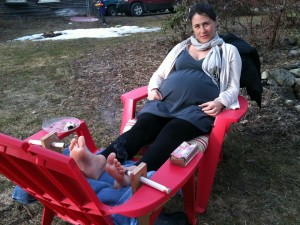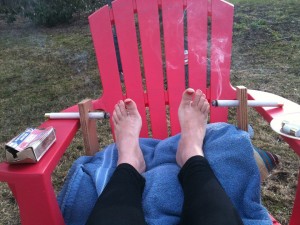November 04, 2013
Can Moxibustion Help Turn Breech Babies?
By: Sharon Muza, BS, LCCE, FACCE, CD/BDT(DONA), CLE | 0 Comments
By Rebecca Dekker, PhD, RN, APRN
Occasional Science & Sensibility contributor Rebecca Dekker of www.EvidenceBasedBirth.com examines the practice of Moxibustion to help turn breech babies head down. Rebecca looks at what the current research shows on this ancient treatment for turning babies and shares the results with Science & Sensibility readers in an article that can be easily shared with students, clients and patients. - Sharon Muza, Science & Sensibility Community Manager.

A mother tries moxibustion to turn her breech
baby. © EvidenceBased Birth.com
About 3-4% of pregnant women end up with a baby who is in breech (bottom first) position at term. The vast majority of these babies (90%) are born by planned cesarean section. In order to avoid a cesarean section, many women try various ways to turn their babies into a head-down position. I have written in the past about using external cephalic version (ECV), also called the hands-to-belly procedure, for turning breech babies. However, although ECV is safe and frequently effective, it can be uncomfortable and women may want to try different options for turning a breech baby. One potential option is moxibustion.
What is moxibustion?
Moxibustion is a type of Chinese medicine where you burn an herb (Artemesia vulgaria) close to the skin of the fifth toes of both feet. The fifth toe is a traditional acupuncture point called Bladder 67.
How do you use moxibustion?
There is no one recommended way to use moxibustion, but many women burn the moxa sticks close to their toes for about 15-20 minutes, from anywhere to 1-10 times per day, for up to two weeks. This treatment is usually started between 28 and 37 weeks of pregnancy.
How could moxibustion work?
The burning of the moxa stick stimulates heat receptors on the skin of the toe. It is thought that the heat encourages the release of two pregnancy hormones - placental estrogen and prostaglandins - which lead to uterine contractions. These contractions can then stimulate the baby to move (Cardini & Weixin, 1998).
So, does moxibustion work?
In 2012, researchers combined results from eight studies where 1,346 women with breech babies were randomly assigned to moxibustion, no treatment, or an alternative treatment (like acupuncture). The women in these studies lived in Italy, China, and Switzerland (Coyle et al., 2012).
For the women who were assigned to receive moxibustion, some used moxibustion alone, some had moxibustion plus acupuncture, and some used moxibustion plus posture techniques.
When moxibustion alone was compared to no treatment (3 studies, 594 women) there was:
- No difference in the percentage of babies who were breech at birth
- No difference in the need for external cephalic version
- No difference in cesarean section rates
- No difference in the risk of water breaking before labor began
- No difference in Apgar scores at birth
- A 72% decrease in the risk of using oxytocin for women in the moxibustion group who ended up with a vaginal birth
Side effects of the moxibustion included smelling an unpleasant odor, nausea, and abdominal pain from contractions.
When moxibustion alone was compared to acupuncture alone, fewer women in the moxibustion group had breech babies at birth compared to the acupuncture group. However, there were only 25 women in the single study that compared moxibustion alone to acupuncture alone, so this doesn't really tell us that much.
When moxibustion plus acupuncture was compared to no treatment (1 study, 226 women), women who had moxibustion plus acupuncture had a:
- 27% decrease in the risk of having a breech baby at birth
- 21% decrease in the risk of having a cesarean section
When moxibustion plus acupuncture was compared to acupuncture alone, one study with only 24 women found no difference in the number of women who had breech babies at birth. Because this study was so small, it doesn't really give us much meaningful information.
When moxibustion plus postural techniques was compared to postural techniques alone (3 studies, 470 women), women in the moxibustion plus postural group had:
- a 74% decrease in the risk of having a breech baby at birth
Are there any limitations to this evidence?

A homemade moxa stick holder helps a mother
administer a moxibustion treatment.
© EvidenceBasedBirth.com
Overall, the studies that were used in this review were good quality. However, some of the studies were very small, and sometimes researchers did not measure things that we would be interested in - for example, when moxibustion plus postural techniques was compared to postural techniques alone, we have no idea if it made a difference in cesarean section rates or any other health results. Also, all of the researchers used different methods of moxibustion. Some women may have had more frequent or longer sessions, and some women may have been more compliant with the therapy than others.
Is there any other good evidence on moxibustion?
After the review above was published, evidence from a new randomized controlled trial that took place in Spain came out in 2013. In this new study, 406 low-risk pregnant women who had a baby in breech position at 33-35 weeks were randomly assigned to true moxibustion, 'fake' moxibustion, or regular care.
What kind of treatments did the women receive?
In the true moxibustion group, the women laid face up, and the hot moxa stick was held near the outside of the little toenail 20 minutes per day for two weeks, changing from one foot to the other when the heat became uncomfortable. The women did the moxibustion at home with the help of a family member. In the fake moxibustion group, the same treatment was carried out, except that the moxa stick was applied to the big toe, which is not a true acupuncture point. Women in all of the groups were educated on how to use a knee-chest posture to try and turn the baby.
Did the moxibustion work?
Women who did moxibustion plus postural techniques were 1.3 times more likely to have a baby in head-down position at birth when compared to both the fake moxibustion and the usual care groups. If you look at the exact numbers, 58% of the women who used moxibustion had a baby who was head-down at birth, compared to 43% of the fake moxibustion group and 45% of the usual care group. The number of women who would need to use moxibustion in order to successfully turn one baby is, on average, eight women.
There was no statistical difference in cesarean section rates among the three groups, but it looked like the numbers were trending in favor of true moxibustion: 51% of the women in the true moxibustion group had cesarean sections, compared to 62% of the fake moxibustion group and 59% of the usual care group.
Were there any safety concerns?
Overall, evidence showed that moxibustion treatment was safe. About 1 out of 3 women reported having contractions during the treatment, but there was no increase in the risk of preterm birth. Some women (14%) said they felt heart palpitations. One woman experienced a burn from the moxibustion. Other complaints from women in all three groups included heartburn, nausea and vomiting (2%), dizziness (1.7%), mild high blood pressure problems (1.7%), stomach pain (1.5%), and baby hiccups (1.2%). However, there were no differences among the three groups in the number of women who had these complaints. There were also no differences in newborn health issues or labor problems among the three groups. All of the babies had good Apgar scores five minutes after birth.
So what's the bottom line?
- Evidence suggests that moxibustion - when combined with either acupuncture or postural techniques - is safe and increases your chances of turning a breech baby
- We still don't know for sure which kind of moxibustion method (timing during pregnancy, number of sessions, length of sessions, etc.) works best for turning breech babies. However it appears that using moxibustion twice per day for two weeks (during 33-35 weeks of pregnancy) will work for 1 out of every 8 women.
- If women are interested in using Chinese medicine (moxibustion and acupuncture) to help turn a breech baby, they may want to consult a licensed acupuncturist who specializes in treatment of pregnant women.
Here is a video where an acupuncture physician shows how to use moxibustion to turn a breech baby:
Thank you to Kiné Fischler L.Ac. of Willow Tree Wellness Clinic, who provided feedback on this article.
As a childbirth educator or other birth professional, do you share information on moxibustion as a method that mothers might use to turn a breech baby? How do you present this information? How do the families you work with feel after learning about this option? If you did not cover this before, do you feel like you might start to include this information in your classes after reading Rebecca's information here and on her blog? Are you aware of physicians who also encourage patients to try this treatment? Please share your experiences in our comments section. I welcome your discussions. - SM
References
Cardini F. & Weixin H. (1998). Moxibustion for correction of breech presentation: A randomized controlled trial. JAMA 280(18), 1580-1584. Free full text: http://jama.jamanetwork.com/article.aspx?articleid=188144
Coyle ME, Smith CA, & Peat B. 2012. Cephalic version by moxibustion for breech presentation. Cochrane Database of Systematic Reviews 2012, Issue 5. Art. No: CD003928. http://www.ncbi.nlm.nih.gov/pubmed/22592693
Vas J, Aranda-Regules JM, Modesto M, et al. (2013). Acupuncture Medicine 31: 31-38. http://www.ncbi.nlm.nih.gov/pubmed/23249535
About Rebecca Dekker
 Rebecca Dekker, PhD, RN, APRN, is an Assistant Professor of Nursing at a research-intensive university and the founder and author of EvidenceBasedBirth.com. Rebecca's vision is to promote evidence-based birth practices among consumers and clinicians worldwide. She publishes summaries of birth evidence using a Question and Answer style. The mission of Evidence Based Birth is to get birth evidence out of medical journals and into the hands of the public. You can follow Rebecca on Facebook, Twitter or follow the Evidence Based Birth newsletter to get free printable handouts and other news.
Rebecca Dekker, PhD, RN, APRN, is an Assistant Professor of Nursing at a research-intensive university and the founder and author of EvidenceBasedBirth.com. Rebecca's vision is to promote evidence-based birth practices among consumers and clinicians worldwide. She publishes summaries of birth evidence using a Question and Answer style. The mission of Evidence Based Birth is to get birth evidence out of medical journals and into the hands of the public. You can follow Rebecca on Facebook, Twitter or follow the Evidence Based Birth newsletter to get free printable handouts and other news.
Tags
Pregnancy Childbirth education Research Evidence Based Birth Rebecca Dekker Breech Labor/Birth Maternal Infant Care Guest Posts Acupuncture Breech Babies External Cephalic Version Moxibustion Mugwort